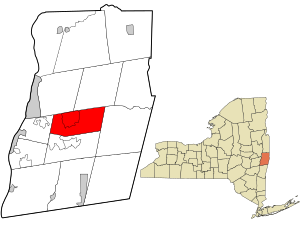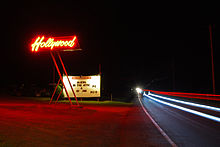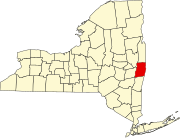Poestenkill, New York
Poestenkill, New York | |
|---|---|
 Location in Rensselaer County and the state of New York. | |
| Coordinates: 42°41′15″N 73°31′17″W / 42.68750°N 73.52139°W | |
| Country | United States |
| State | New York |
| County | Rensselaer |
| Settled | 1770 |
| Incorporated | March 2, 1848[1] |
| Government | |
| • Town Supervisor | Tom Russell[2] |
| Area | |
• Total | 32.57 sq mi (84.37 km2) |
| • Land | 32.35 sq mi (83.80 km2) |
| • Water | 0.22 sq mi (0.57 km2) |
| Elevation | 928 ft (283 m) |
| Population (2020) | |
• Total | 4,322 |
| Time zone | UTC-5 (Eastern (EST)) |
| • Summer (DST) | UTC-4 (EDT) |
| ZIP code | 12140 |
| Area code | 518 |
| FIPS code | 36-58805 |
| GNIS feature ID | 0979380 |
| Website | poestenkillny.com |
Poestenkill is a town in Rensselaer County, New York, United States. The population was 4,322 at the 2020 census.[5] The town is southeast of Troy and is centrally located in the county.
The town is named after the Poesten Kill, an important stream in the area.[6] The phrase poesten kil (with only one l) is traditionally said to be Dutch for "foaming water" or "foaming creek".[7][8] While kil is, indeed, Dutch for "water" or "creek", Dutch dictionaries do not support the claim of poest meaning "foam".[9][10] It seems more likely that the creek was named after the nickname Poest for the 17th-century local farmer and miller Jan Barentsen Wemp, who had a pimple (poest) or had difficulty breathing (poesten = to breathe); he owned a farm and a mill on the Poestenkil creek.[11][12]
Among the earliest settlers in the town was Archelaus Lynd. He leased 300 acres of land from the Van Rensselaers and made his first clearing in the area of Hillside Cemetery, which was known as The Lynd Cemetery until about 1900. The Whyland and Ives families were other early settlers.
History
[edit]

The area was first settled around 1770, and the town of Poestenkill was created from part of the Town of Sand Lake on March 2, 1848.[6][1]
When the American Revolutionary War broke out, six men served from the area. One, named Benjamin Cotterel, is said to have carried the first wheelbarrow of earth to Bunker Hill.[6]
The first school in the area was established in or soon after 1788 on land set aside for that purpose by Stephen Van Rensselaer III.[6] Five men from Poestenkill served in the War of 1812, all joining the Eddy expedition.[6]
The first regular church in Poestenkill was the First Baptist church, organized in 1814 and located in East Poestenkill.[6]
During the American Civil War, many of Poestenkill's men served with the Union's forces; twelve who died in action were Daniel M. Horton, Philip Amidon, Daniel Morrison, John Wagoner, George Bradt, Dexter Randall, William H. H. Wood, Martin Larabee, Willard Bailey, W. L. Robbins, George Simmons, and William H. Mason.[6]
Future president James A. Garfield considered a job as high school principal in Poestenkill in 1856, though lost it to another applicant.[13]
Poestenkill celebrated its sesquicentennial (150th anniversary) in 1998, with several events including a Revolutionary War reenactment, antique car show, a parade, and a historical display. A postcard was also produced for the town at the time.
Geography
[edit]According to the United States Census Bureau, the town has a total area of 32.6 square miles (84 km2), of which 32.5 square miles (84 km2) is land and 0.1 square miles (0.26 km2) (0.43%) is water.
The eastern and central portions of the town are part of the Rensselaer Plateau.[14]
The town is serviced in part by Brunswick (Brittonkill) Central School District and by Averill Park Central School District.
Location
[edit]Demographics
[edit]| Census | Pop. | Note | %± |
|---|---|---|---|
| 1850 | 2,092 | — | |
| 1860 | 1,833 | −12.4% | |
| 1870 | 1,769 | −3.5% | |
| 1880 | 1,672 | −5.5% | |
| 1890 | 1,602 | −4.2% | |
| 1900 | 1,362 | −15.0% | |
| 1910 | 1,078 | −20.9% | |
| 1920 | 1,002 | −7.1% | |
| 1930 | 1,164 | 16.2% | |
| 1940 | 1,438 | 23.5% | |
| 1950 | 1,799 | 25.1% | |
| 1960 | 2,493 | 38.6% | |
| 1970 | 3,426 | 37.4% | |
| 1980 | 3,664 | 6.9% | |
| 1990 | 3,809 | 4.0% | |
| 2000 | 4,054 | 6.4% | |
| 2010 | 4,530 | 11.7% | |
| 2020 | 4,322 | −4.6% | |
| U.S. Decennial Census[15][5] | |||

As of the census[16] of 2000, there were 4,054 people, 1,527 households, and 1,137 families residing in the town. The population density was 124.9 inhabitants per square mile (48.2/km2). There were 1,628 housing units at an average density of 50.2 units per square mile (19.4 units/km2). The racial makeup of the town was 98.35% White, 0.17% Blacks and or African American, 0.30% Native American, 0.35% Asian, 0.27% from other races, and 0.57% from two or more races. Latinx of any race were 0.67% of the population.
There were 1,527 households, out of which 36.4% had children under the age of 18 living with them, 61.6% were married couples living together, 9.0% had a female householder with no husband present, and 25.5% were non-families. 20.0% of all households were made up of individuals, and 7.6% had someone living alone who was 65 years of age or older. The average household size was 2.64 and the average family size was 3.07.
In the town, the population was spread out, with 26.9% under the age of 18, 6.0% from 18 to 24, 30.6% from 25 to 44, 25.7% from 45 to 64, and 10.8% who were 65 years of age or older. The median age was 38 years. For every 100 females, there were 104.1 males. For every 100 females age 18 and over, there were 100.2 males.
The median income for a household in the town was $58,945, and the median income for a family was $63,819. Males had a median income of $40,128 versus $29,486 for females. The per capita income for the town was $22,143. About 0.5% of families and 1.7% of the population were below the poverty line, including 1.0% of those under age 18 and 3.0% of those age 65 or over.
Communities and locations in Poestenkill
[edit]- Barberville – A hamlet southeast of Poestenkill village at the junction of Plank and Blue Factory roads. The community derives its name from a local family.[17]
- East Poestenkill (formerly "Columbia") – A hamlet in the southeastern part of the town at the junction of Plank and Legenbauer roads.
- Ives Corner – A hamlet east of Poestenkill village at the junction of Plank and Columbia Hill roads. The community was named after the local Ives family.[18]
- Poestenkill – The hamlet of Poestenkill at the junction of Routes 68 and 351
- Rensselaer County Airport (5B7) – An airport in the northwestern part of the town. The airport is not large enough to take on any large commercial airplanes, only small privately owned planes.
- Poestenkill Library – A local library connected to the Upper Hudson Library System. This location serves as a community center where town events are held. These events include: singers, book sales, Fourth of July Parties, Children's reading hour, and other events.
- Barberville Falls – A waterfall that connects into the Poestenkill creek. Includes a small trail and views of the waterfall. Swimming is prohibited.
References
[edit]- ^ a b Sullivan, James; Williams, Melvin E.; Conklin, Edwin P.; Fitzpatrick, Benedict, eds. (1927), "Chapter VI. Rensselaer County.", History of New York State, 1523–1927 (PDF), vol. 2, New York City, Chicago: Lewis Historical Publishing Co., p. 459, hdl:2027/mdp.39015019994048, Wikidata Q114149636
- ^ "Town Supervisor". Town of Poestenkill. Retrieved August 29, 2024.
- ^ "2016 U.S. Gazetteer Files". United States Census Bureau. Retrieved July 5, 2017.
- ^ a b "Population and Housing Unit Estimates". Retrieved June 9, 2017.
- ^ a b U.S. Census Bureau, 2020 census results, Poestenkill. https://www.census.gov/search-results.html?searchType=web&cssp=SERP&q=Poestenkill%20town,%20Rensselaer%20County,%20New%20York
- ^ a b c d e f g Anderson, George Baker (1897). "XXXII". Landmarks of Rensselaer County: Town of Poestenkill. Syracuse NY: D. Mason. Retrieved June 7, 2007.
- ^ Munsell, Joel (1852). The Annals of Albany. Volume III. Albany: Joel Munsell. p. 59. Retrieved April 23, 2009.
- ^ Gobert, T.A.; Cara Manley; Richard Montena (April 25, 2007). "Natural Features of Mount Ida" (PDF). mountidatroy.org. Retrieved April 23, 2009.
- ^ The obsolete Dutch word poest is retained in at least the dialect of Drenthe and can mean there (see dialect dictionary of Drents (Dutch province language)) 1. pimple (modern Dutch: de puist) 2. breath 3. illness: breathlessness 4. small bridge of which the middle part can be taken out 5. wooden board that can be placed over a stream 6. blowpipe (1m long) for the fireplace. If we may extrapolate these dialect meanings to seventeenth century NY Dutch language, then common sense would suggest meaning 4: Poestenkil = Creek with the little bridge with the movable middle, or 5. Creek with the board. Perhaps there are old pictures of a bridge over the Poestenkil ? Alternatively, there might have been a Dutch settler by the (nick)name of Poest (perhaps with a pimple?), so that the name would mean say "Mr. Pimple's Creek".
- ^ Neither does the extensive multivolume Woordenboek der Nederlandse Taal WNL give the meaning "froth" or "bubbly" for poest, but is in line with the meanings given above (offers also: cowshed, piece of wood and the verb poesten (blow, brag, kiss, fight, what not! .... online results in Dutch to add to the confusion..).
- ^ See "Dutch Colonial Remains America 1600-1800". Archived from the original on May 9, 2008. Retrieved April 30, 2008. and, e.g., http://history.rays-place.com/ny/ren-troy-village-ny.htm on Jan Barentsen Wemp or Wamp.
- ^ Wemp or Poest owned a farm and a mill on the creek
- ^ Peskin, Allan (1978). Garfield. Kent State University Press. pp. 45. ISBN 0-87338-210-2.
- ^ "Rensselaer Plateau Association – Maps". Archived from the original on December 24, 2013. Retrieved August 26, 2013.
- ^ "Census of Population and Housing". Census.gov. Retrieved June 4, 2015.
- ^ "U.S. Census website". United States Census Bureau. Retrieved January 31, 2008.
- ^ University of the State of New York Bulletin. University of the State of New York. 1914. p. 51.
- ^ University of the State of New York Bulletin. University of the State of New York. 1914. p. 52.
Further reading
[edit]- Anderson, George Baker (1897). Landmarks of Rensselaer County New York. Syracuse, New York: D. Mason and Company. OCLC 1728151.
- Hayner, Rutherford (1925). Troy and Rensselaer County New York: A History. New York: Lewis Historical Publishing Company, Inc. OCLC 22524006.
- Sylvester, Nathaniel Bartlett (1880). History of Rensselaer Co., New York with Illustrations and Biographical Sketches of its Prominent Men and Pioneers. Philadelphia: Everts & Peck. OCLC 3496287.
- Weise, Arthur James (1880). History of the Seventeen Towns of Rensselaer County from the Colonization of the Manor of Rensselaerwyck to the Present Time. Troy, New York: J. M. Francis & Tucker. OCLC 6637788.


